Flying Cars with Venetian Blinds: 1942 Predictions for the Car of the Future
World War II wouldn’t be over for almost two more years, but Americans were already dreaming about their post-war cars.
So in 1942, the Post asked several auto designers what Americans could expect to see when Detroit began making passenger cars again. Author Edward R. Grace reported, “If our seven prophets are accurate, the postwar era will see more people than ever going places sitting down and they will go faster, more cheaply, and more comfortably, and in lighter, handsomer motorcars.”
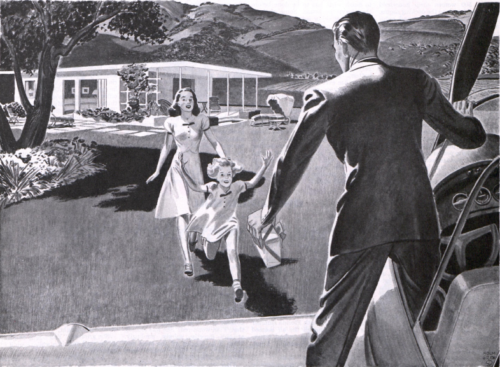
Predictions that Missed the Mark
While some of the designers’ predictions proved accurate, others were wildly fanciful.
-
- Car bodies of molded plastic and plywood
Designers believed plastic could be developed that had 90% of the impact strength of steel. Molded-plastic auto bodies would reduce the weight of automobiles, making them more fuel efficient.The idea of plywood had been borrowed from the combat gliders developed by the Army. The plywood-construction idea was still a promising concept back in 1942, before the gliders were used in the European invasion and earned the nickname “flying coffins.” - Plastic roofs with venetian blinds
“Plastics which permit the transmission of ultra-violet rays will give the passenger a good tan without the discomfort of sunburn, due to the elimination of the infra-red rays,” said a Ford Motor Company designer. “A lightweight venetian blind will control the amount of light desired.”He made these comments at a time when few were aware that tanning could lead to skin cancer. Also, he appears not to have known that it is ultraviolet rays, not infrared, that causes sunburn (although both kinds of radiation can cause cancer).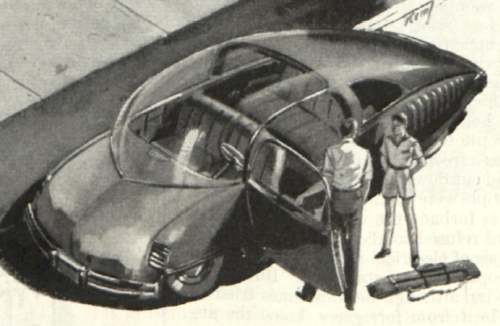
Detail from a January 1943 ad for Celotex building materials. - No steering wheel or windshield wipers
Steering levers were proposed as more powerful, responsive alternatives to steering wheels. Heated windshields would somehow eliminate the need for windshield wipers. - Competition from the aviation industry
America had been remarkably successful in producing aircraft and training pilots on a massive scale for the war. Some auto designers believed that, after the war, aircraft manufacturers would “turn out practicable planes at prices about the same as present-day automobile prices,” said Grace.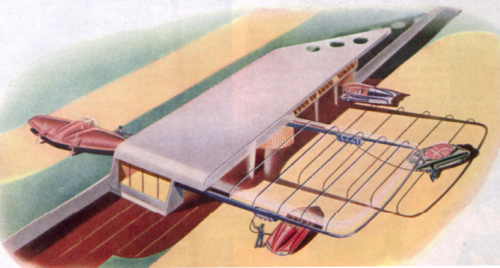 The idea of Americans owning their own planes inspired some of the more fantastic ideas. A designer who’d worked for Packard expected to see “homes, offices, and public buildings designed to accommodate travel by air, which will give an entirely new functional value to roofs. I am confident that there will be many air-colony settlements. You are going to see service stations along our highways designed to accommodate both motorcars and planes.”
The idea of Americans owning their own planes inspired some of the more fantastic ideas. A designer who’d worked for Packard expected to see “homes, offices, and public buildings designed to accommodate travel by air, which will give an entirely new functional value to roofs. I am confident that there will be many air-colony settlements. You are going to see service stations along our highways designed to accommodate both motorcars and planes.”
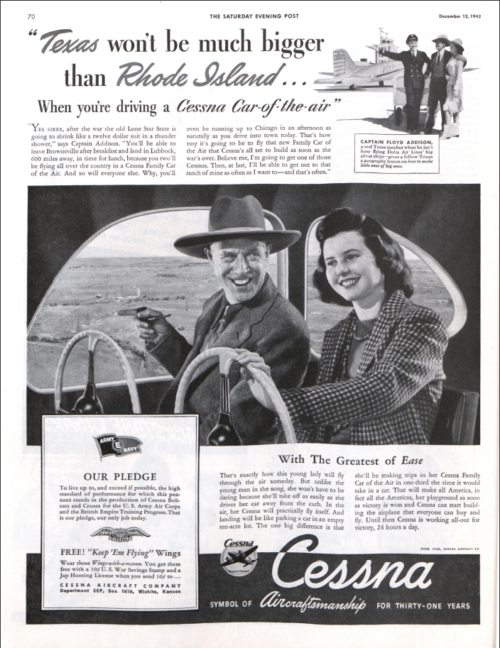
A Cessna ad from 1942 promising a “Car-of-the-air.”
- Car bodies of molded plastic and plywood
Predictions that Came True
But some predictions were spot on:
-
-
- Lighter engines
Building aircraft for the military had taught the auto industry a lot about reducing engine weight. A Chrysler engineer said pre-war auto engines weighed five times as much as an airplane engine that delivered the same horsepower. “It’s possible to eliminate two hundred and fifty from the prevent average of six hundred pounds” — which is close to current range of engine weights. - New, sleeker designs
GM Vice President Harley Earl said the days of the traditional, boxy sedan were over. Postwar cars would do away with the static look. “The public wants low, racy styles,” he said, “fast-looking, graceful cars that are functional in appearance. - A lot more cars on the road
Even though many planners were expecting America would go into a recession when the war ended, GM’s Earl predicted the auto industry would see unprecedented growth. By 1952, he said, the number of automobiles in America would reach 50,000,000, almost twice the number registered in 1941. He was only off by 10%. - Tires that automatically adjust pressure
One designer predicted tires that would automatically adjust pressure according to the road on which they’re travelling. While this feature hasn’t yet arrived, Michelin is developing an airless tire, made of recycled materials, with 3D printed treads that can be changed to accommodate road conditions.
Regardless of what America expected in postwar automobiles, what they got, when commercial-vehicle production resumed in 1945, were 1942 models with new front grills and trimmings. Detroit didn’t turn out any fully new automobiles for another four years.
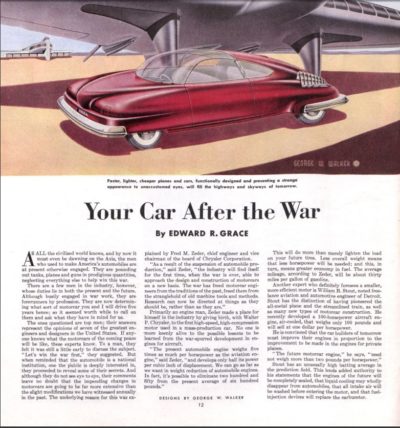
Read “Your Car After the War,” from the November 14, 1942, issue of the Post. - Lighter engines
-
Cartoons: Home Improvement
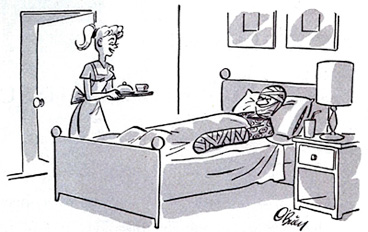
“How’s old Do-it-Yourself this morning?”
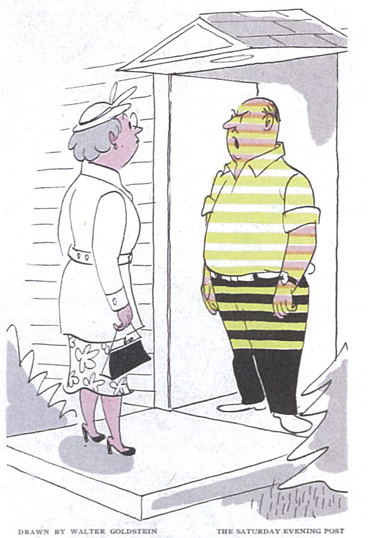
“She’s in the back, spraying venetian blinds.”
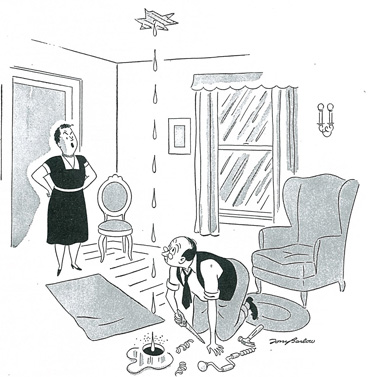
“That certainly isn’t how I’d fix a leak in the roof.”
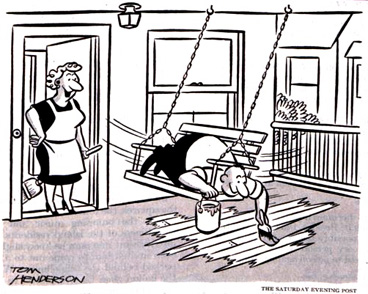
“Say, now, aren’t you the clever one?”
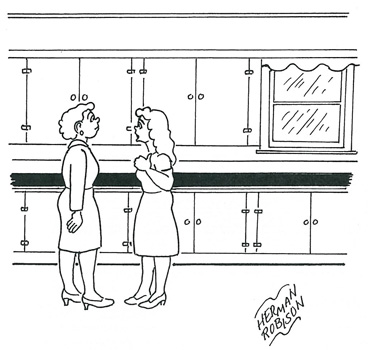
“Charlie saved a bundle by
building our cabinets himself … that is,
if you don’t count what the hospital charged for sewing his thumb back on.”
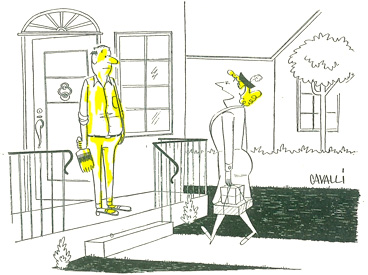
“Well! I just hope my living room walls look half as pretty as you do!”